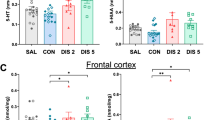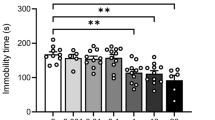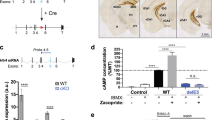Abstract
Aim:
To investigate the effects of the novel N6-substituted adenosine derivative {(2R,3S,4R,5R)-3,4-dihydroxy-5-[6-[(4-hydroxy-3-methoxybenzyl)amino]-9H-purin-9-yl]tetrahydrofuran-2-yl} methyl decanoate (WS0701) on stress-induced excessive fear, anxiety, and cognitive deficits in a mouse model of posttraumatic stress disorder (PTSD).
Methods:
Male mice underwent a conditioned foot shock and single prolonged stress procedure to induce PTSD. Contextual/cued fear, elevated plus-maze, open field and novel object recognition tests were conduced to assess PTSD-like behaviors. From d 1, the mice were orally administered WS0701 (7.5, 15, or 30 mg·kg-1·d-1) or paroxetine (10 mg·kg-1·d-1) for two weeks. Apoptosis of hippocampal neurons was detected using flow cytometry and TUNEL staining, and expression of Bcl-2 and Bax in the hippocampus was measured with Western boltting and qPCR assays.
Results:
WS0701 administration significantly alleviated fear, anxious behaviors and memory deficits in the mouse model of PTSD. Furthermore, WS0701 administration significantly reduced the stress-induced apoptosis of hippocampal neurons, and increased the Bcl-2/Bax ratio in the hippocampus. The positive control drug paroxetine exerted similar effects on PTSD-like behaviors and hippocampal neuron apoptosis in the mouse model of PTSD, which were comparable to those caused by the high dose of WS0701.
Conclusion:
WS0701 effectively mitigates stress-induced PTSD-like behaviors in mice, partly via inhibition of neuronal apoptosis in the hippocampus.
Similar content being viewed by others
Log in or create a free account to read this content
Gain free access to this article, as well as selected content from this journal and more on nature.com
or
References
American Psychiatric Association. Diagnostic and statistical manual of mental disorders fourth edition text revision (DSM-IV-TR). Washington DC: American Psychiatric Association; 2000.
Nemeroff CB, Bremner JD, Foa EB, Mayberg HS, North CS, Stein MB . Posttraumatic stress disorder: a state-of-the-science review. J Psychiatr Res 2006; 40: 1–21.
Quirk GJ, Mueller D . Neural mechanisms of extinction learning and retrieval. Neuropsychopharmacology 2008; 33: 56–72.
Nutt DJ . The psychobiology of posttraumatic stress disorder. J Clin Psychiatry 2000; 61: 24–9.
Shin LM, Rauch SL, Pitman RK . Amygdala, medial prefrontal cortex, and hippocampal function in PTSD. Ann N Y Acad Sci 2006; 1071: 67–79.
Steckler T, Risbrough V . Pharmacological treatment of PTSD - established and new approaches. Neuropharmacology 2012; 62: 617–27.
Lopes LV, Sebastiao AM, Ribeiro JA . Adenosine and related drugs in brain diseases: present and future in clinical trials. Curr Top Med Chem 2011; 11: 1087–101.
Watanabe N, Obuchi T, Tamai M, Araki H, Omura S, Yang JS, et al. A novel N6-substituted adenosine isolated from mi huan jun (Armillaria mellea) as a cerebral-protecting compound. Planta Med 1990; 56: 48–52.
Chen B, Yang B, Yang LX, Lu ZH . Effects of AMG-1 on the PTZ-kindling seizures in mice. Neural Injury and Functional Reconstruction 2009; 4: 173–5.
Liu L, Feng YP, Hu D, Li HS, Zhang JT . Effects of AMG-1 on energy metabolism and neuronal damage of ischemic brain in mice and rats. Yao Xue Xue Bao 1991; 26: 881–5.
Liu L, Feng YP . Effect of AMG-1 and adenosine on glutamate release from synaptosomes in rats. Yao Xue Xue Bao 1993; 28: 881–5.
Li WP, Feng YP, Zhang JT . Effect of AMG-1 on free intrasynaptosome calcium level and on the isolated artery contraction induced by norepinephrine. Yao Xue Xue Bao 1994; 29: 721–4.
Wu S, Hao LH, Du GH . Inventors; institute of materia medica, Chinese Academy of Medical Sciences & Peking Union Medical College, assignee. A new kind of adenosine derivatives and its preparation method. CN patent 200910081639.6. 2009 Apr 07.
Wang H, Zuo D, He B, Qiao F, Zhao M, Wu Y . Conditioned fear stress combined with single-prolonged stress: a new PTSD mouse model. Neurosci Res 2012; 73: 142–52.
Khan S, Liberzon I . Topiramate attenuates exaggerated acoustic startle in an animal model of PTSD. Psychopharmacology (Berl) 2004; 172: 225–9.
Monsef-Esfahani HR, Amini M, Goodarzi N, Saiedmohammadi F, Hajiaghaee R, Faramarzi MA, et al. Coumarin compounds of Biebersteinia multifida roots show potential anxiolytic effects in mice. Daru 2013; 21: 51.
Campos AR, Barros AI, Albuquerque FA, M Leal LK, Rao VS . Acute effects of guarana (Paullinia cupana Mart) on mouse behaviour in forced swimming and open field tests. Phytother Res 2005; 19: 441–3.
Zhang R, Xue G, Wang S, Zhang L, Shi C, Xie X . Novel object recognition as a facile behavior test for evaluating drug effects in AbetaPP/PS1 Alzheimer's disease mouse model. J Alzheimers Dis 2012; 31: 801–12.
Bilsland JG, Haldon C, Goddard J, Oliver K, Murray F, Wheeldon A, et al. A rapid method for the quantification of mouse hippocampal neurogenesis in vivo by flow cytometry. Validation with conventional and enhanced immunohistochemical methods. J Neurosci Methods 2006; 157: 54–63.
Kyrylkova K, Kyryachenko S, Leid M, Kioussi C . Detection of apoptosis by TUNEL assay. Methods Mol Biol 2012; 887: 41–7.
Ferreira ID, Rosario VE, Cravo PV . Real-time quantitative PCR with SYBR Green I detection for estimating copy numbers of nine drug resistance candidate genes in Plasmodium falciparum. Malar J 2006; 5: 1.
Siegmund A, Wotjak CT . A mouse model of posttraumatic stress disorder that distinguishes between conditioned and sensitised fear. J Psychiatr Res 2007; 41: 848–60.
Yamamoto S, Morinobu S, Takei S, Fuchikami M, Matsuki A, Yamawaki S, et al. Single prolonged stress: toward an animal model of posttraumatic stress disorder. Depress Anxiety 2009; 26: 1110–7.
Takahashi T, Morinobu S, Iwamoto Y, Yamawaki S . Effect of paroxetine on enhanced contextual fear induced by single prolonged stress in rats. Psychopharmacology 2006; 189: 165–73.
Ipser JC, Stein DJ . Evidence-based pharmacotherapy of post-traumatic stress disorder (PTSD). Int J Neuropsychopharmacol 2012; 15: 825–40.
Holbrook TL, Galarneau MR, Dye JL, Quinn K, Dougherty AL . Morphine use after combat injury in Iraq and post-traumatic stress disorder. N Engl J Med 2010; 362: 110–7.
Szczytkowski-Thomson JL, Lebonville CL, Lysle DT . Morphine prevents the development of stress-enhanced fear learning. Pharmacol Biochem Behav 2013; 103: 672–7.
Chen JF, Sonsalla PK, Pedata F, Melani A, Domenici MR, Popoli P, et al. Adenosine A2A receptors and brain injury: broad spectrum of neuroprotection, multifaceted actions and “fine tuning” modulation. Prog Neurobiol 2007; 83: 310–31.
Alsene K, Deckert J, Sand P, de Wit H . Association between A2a receptor gene polymorphisms and caffeine-induced anxiety. Neuropsychopharmacology 2003; 28: 1694–702.
Acknowledgements
This study was supported by the International S&T Cooperation Projects (No 2009DFA32010), the National Scientific and Technological Major Project (2009ZX09102-003 and 2013ZX09J13102-05C), and the Special Foundation for Public Welfare Industry of Health (No 200902008), China.
Author information
Authors and Affiliations
Corresponding author
Rights and permissions
About this article
Cite this article
Huang, Zl., Liu, R., Bai, Xy. et al. Protective effects of the novel adenosine derivative WS0701 in a mouse model of posttraumatic stress disorder. Acta Pharmacol Sin 35, 24–32 (2014). https://doi.org/10.1038/aps.2013.143
Received:
Accepted:
Published:
Issue date:
DOI: https://doi.org/10.1038/aps.2013.143
Keywords
This article is cited by
-
The effect of SSRIs on fear learning: a systematic review and meta-analysis
Psychopharmacology (2023)
-
Adenosine: a partially discovered medicinal agent
Future Journal of Pharmaceutical Sciences (2021)
-
PTSD as a Public Mental Health Priority
Current Psychiatry Reports (2019)
-
Prevention of Trauma and Stressor-Related Disorders: A Review
Neuropsychopharmacology (2016)
-
Experimental Post-traumatic Stress Disorder Decreases Astrocyte Density and Changes Astrocytic Polarity in the CA1 Hippocampus of Male Rats
Neurochemical Research (2016)



